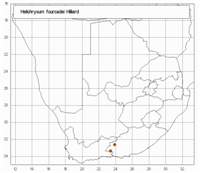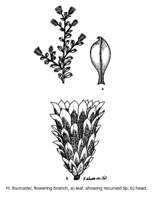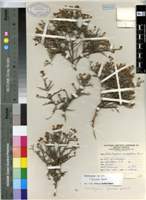Origin of name:
fourcadei = after George Henri Fourcade (1866-1948) a forester in southern Cape, in charge of the Forest Herbarium in Knysna in 1882.
Diagnostic characters:
Small silvery spathulate leavesSolitary capitulaReddish-brown bracts
Description:
Twiggy shrub, height unknown, but probably dwarf, branchlets rigid, closely appressed silvery-grey woolly, leafy. Leaves 3-9 x 1-3 mm, spathulate, apex obtuse, uppermost small leaves subacute, mucronate, recurved, base much narrowed, very shortly decurrent, webbed to the stems, both surfaces silvery-grey felted with a papery surface. Heads homogamous, turbinate-cylindric, c. 6 x 4 mm, solitary or 2-3 loosely arranged at the branchlet tips. Involucral bracts in c. 8 series, graded, imbricate, backs woolly, reddish above the stereome, tips reddish brown, obtuse or subacute, squarrose. Receptacle more or less smooth. Flowers c. 20-24. Achenes not seen, ovaries with myxogenic duplex hairs. Pappus bristles many, scabrid, tips barbellate, bases probably cohering strongly by patent cilia.
Flowering in December.
Distribution:
Known from the type collection and one other, from near Aberdeen.
Nama Karoo Biome.
Notes:
The small silvery spathulate leaves and small more or less solitary heads with reddish brown squarrose involucral bracts combine to make this a very distinctive species.
Taxonomy:
Literature:
Helichrysum fourcadei Hilliard in Flora of southern Africa 33,7 (2): 131 (1983).
Type:
Western Cape, Uniondale div., 19 miles from Uniondale on Willowmore road, Karoo S. of Olifants River, 29 xi 1942, Fourcade 5848 (BOL, holo.; NBG, iso.).
Synonym(s):
Vouchers:
Maguire 737 (NBG).


